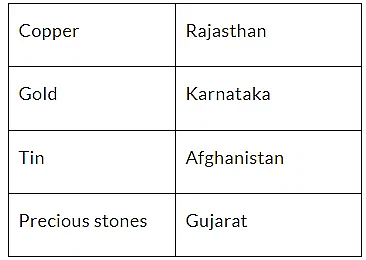NCERT Solutions for Class 6 History - In The Earliest Cities
Let’s Recall
Q1. How do archaeologists know that cloth was used in the Harappan civilisation?
Ans: Archaeologists have discovered actual pieces of cloth attached to artifacts such as the lid of a silver vase and some copper objects at Mohenjodaro. Additionally, they have found spindle whorls made of terracotta and faience, which were used for spinning thread, providing further evidence of the use of cloth in the Harappan civilization.
Q2. Match the columns
Ans:

Q3. Why were metals, writing, the wheel, and the plough important for the Harappans?
Ans: Things and its importance:
- Metals – For making tools, weapons, ornaments and vessels
- Writing – For maintaining records.
- Wheels – Used as means of transport.
- Ploughing – For tilling the land so that farming could be done.
Let’s Discuss
Q4. Make a list of all the terracotta toys shown in the lesson. Which do you think children would have enjoyed playing with the most?
Ans: List of terracotta toys shown in the lesson:
- Animal figures
- Wheeled vehicles
- Toy plough
Children would have enjoyed playing with the wheeled vehicles most. Terracotta toys of Harappa
Terracotta toys of Harappa
Q5. Make a list of what the Harappans ate, and put a tick mark against the things you eat today.
Ans: The Harappans consumed a variety of food items including wheat, barley, pulses, mustard, peas, and linseed. While rice consumption among the Harappans is debated, many of these food items are still commonly consumed today, such as wheat, barley, pulses, and peas.
Q6. Do you think that the life of farmers and herders who supplied food to the Harappan cities was different from that of the farmers and herders you read about in Chapter 2? Give reasons for your answer.
Ans: 
Let’s do
Q7. Describe three important buildings in your city or village. Are they located in a special part of the settlement (e.g. the centre)? What are the activities that take place in these buildings?
Ans: [In this question, you'll have the chance to come up with your own response. However, we've also included an example answer below to give you an idea of what's expected. ]
The three important building in my city, Delhi, are:
(i) Rashtrapati bhavan: It is the official residence of the president of india.
(ii) Parliment house: Here the elected representatives of the people meet and discuss all important issues regarding the country.
(iii) Supreme court: It is the highest court of the country where all the cases are decided. The building is called the surpeme court building.
Q8. Are there any old buildings in your locality? Find out how old they are and who looks after them.
Ans: [In this question, you'll have the chance to come up with your own response. However, we've also included an example answer below to give you an idea of what's expected. ]
An exemplary old building in my locality is the Red Fort, which served as a residence for numerous Mughal emperors. Construction began in 1639, and it took nearly nine years to complete. The Archaeological Survey of India, a governmental organization, is responsible for the preservation and maintenance of the Red Fort, ensuring its historical significance is preserved for future generations.
|
69 videos|386 docs|80 tests
|
FAQs on NCERT Solutions for Class 6 History - In The Earliest Cities
| 1. What is the significance of the Indus Valley Civilization? |  |
| 2. What were the primary occupations of the people in the Indus Valley Civilization? |  |
| 3. What was the political structure of the Indus Valley Civilization? |  |
| 4. What led to the decline of the Indus Valley Civilization? |  |
| 5. What are some of the enduring legacies of the Indus Valley Civilization? |  |























